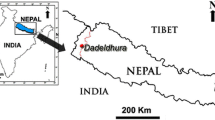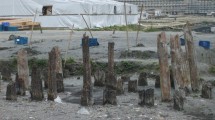Abstract
Studies were carried out on samples of lignite from two quarries at Pietrafitta and Bastardo. They are located in Central Italy not far from the fossil forest of Dunarobba, which was made up of the species Taxodioxylon gypsaceum. Chemotaxonomy on the samples provided the opportunity to decide whether the constituting material of their amorphous bulk is the same as that of the fossil forest or whether they derived from the hardwood species randomly found within the quarries. The identification was carried out by means of residual terpenes recovered by steam distillation and analyzed using the GC-MS technique. The terpenes of Pietrafitta were closely related to those supplied by trunks of Dunarobba, while terpenes from Bastardo showed the same enrichment exhibited by Taxodioxylon gypsaceum findings at Wackerdorf (Germany). The bulk material of both lignites results, therefore, as having been made up of Taxodioxylon gypsaceum and hardwood trunks merely represent intrusions. The identification allows to outline the importance and distribution of this species during the Pliocene period in Central Italy and Central Europe. The use of chemotaxonomy for more degraded samples, however, becomes more difficult and further information is needed.
Zusammenfassung
Untersucht wurden Lignite aus zwei Steinbrüchen bei Pietrafitta und Bastardo in Mittelitalien. Sie liegen in der Nähe des fossilen Waldgebietes von Dunarobba, das überwiegend mit Taxodioxylon gypsaceum bewachsen war. Chemotaxonomische Untersuchungen der Proben boten die Möglichkeit zu untersuchungen der Proben boten die Möglichkeit zu unterscheiden, ob die amorphen Bestandteile der Versteinerungen mit denen der fossilen Hölzer übereinstimmt, oder ob sie aus zufällig im Bereich der Steinbrüche vorhandenen Arten stammen. Die Identifizierung gelang anhand der noch vorhanden Terpene, die durch Wasserdampfdestillation gewonnen und anschließend durch GC-MS-Methoden anlysiert wurden. Die Terpene der Fundstücke aus Pietraffitta waren sehr nahe verwandt mit denen aus Dunarobba-Stämmen, wogegen die Terpene aus Bastardo eine ähnliche Anreicherung zeigten wie in fossilen Funden von Taxodioxylon gypsaceum bei Wackersdorf (Deutschland). Das Material der beiden Lignite kann demnach auf diese Holzart zurückgeführt werden. Die Ergebnisse erlauben Rückschlüsse auf die Verbreitung der Art in Italien und Mitteleuropa während der Pliocän-Epoche. Für die chemotaxonomische Bestimmung stärker abgebauter fossiler Proben sind jedoch noch weitere Informationen nötig.
Similar content being viewed by others
References
Ambrosetti, A.: Private communication
Menchi, G.; Matteoli, U.; Staccioli, G.; Fengel, D. 1995: Long Term Degradation of Terpenes From a 20 Million Years Old Taxodioxylon gypsaceum. Holzforschung 49: 394–396
Panshin, A. J.; De Zeeuw, C.; Brown, H. P. 1964: Textbook of Wood Technology, vol I, Mc Graw-Hill New York
Philp, R. P. 1985: Fossil Fuel Biomarkers. Application and spectra. Elsevier Amsterdam, p. IX
Staccioli, G.; Mellerio, G.; Bambagiotti Alberti, M. 1993: Investigation on terpene-related hydrocarbons from a Pliocenic fossil wood. Holzforschung 47: 339–342
Staccioli, G.; Seraglia, R.; Traldi, P.; Menchi, G.; Matteoli, U. 1994: Nature of terpenoids of a Taxodioxylon gypsaceum from the fossil forest of Dunarobba (Italy). Holz Roh- Werkstoff 52: 39–41
Streill, M.; Kristin, M.; Krupcic, J.; Stransky, K. 1972: Investigations on the Chemical Composition of Novaky Brown Coal VI. Occurrence of α-phyllocladane in Slovakian Lignite. An. de Quimica 68: 979–982
Zavarin, E.; Cool, L. 1991: Extraneous Materials from Wood. Wood Structure and Composition. M. Lewin, I. S. Goldstein, Eds, M. Dekker, New York, 345–348
Author information
Authors and Affiliations
Rights and permissions
About this article
Cite this article
Staccioli, G., Menchi, G. & Matteoli, U. Taxodioxylon gypsaceum as parent botanical species of two lignites of central Italy. Holz als Roh-und Werkstoff 54, 259–261 (1996). https://doi.org/10.1007/s001070050177
Issue Date:
DOI: https://doi.org/10.1007/s001070050177




